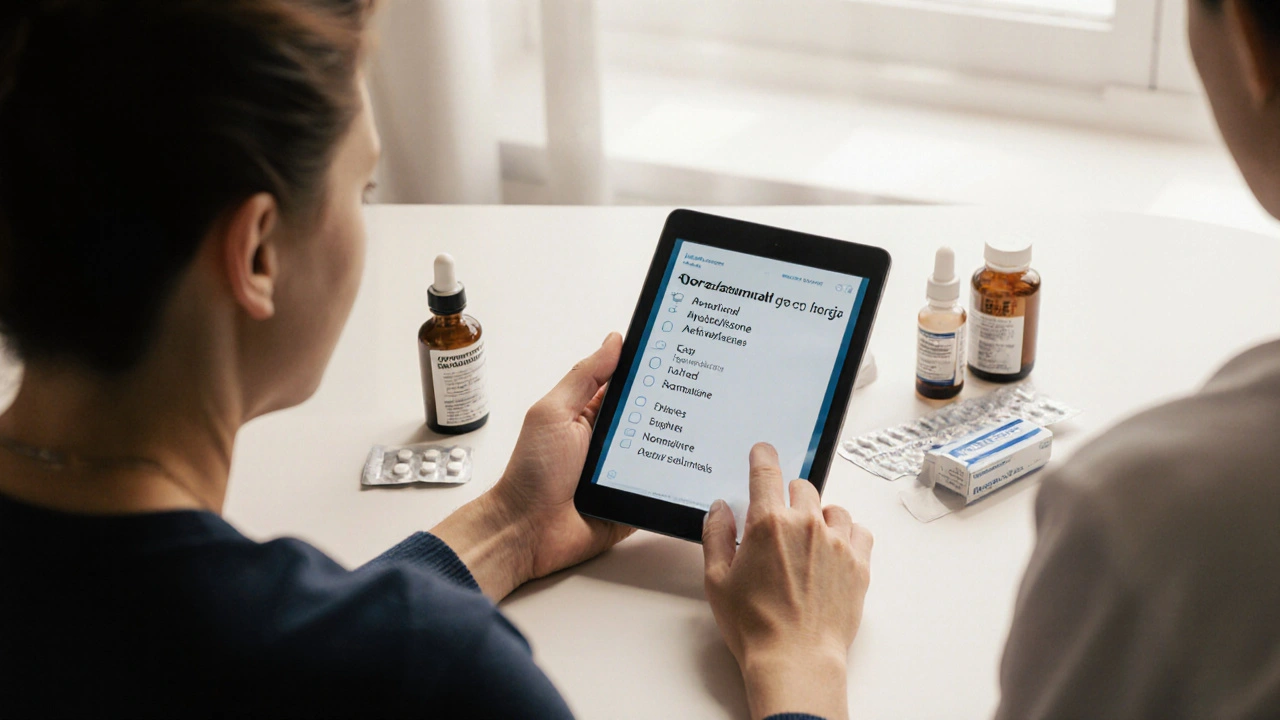Acetazolamide vs Alternatives: Drug Comparison Tool
| Drug | Indication | Side Effects | Dosage Form | Special Notes |
|---|
Quick Guide
Use the filters above to compare medications for your specific condition. For example:
- For glaucoma, consider topical CAIs like dorzolamide or brinzolamide
- For altitude sickness, oral CAIs like acetazolamide or methazolamide are preferred
- If you have a sulfa allergy, avoid acetazolamide and methazolamide
When treating conditions like glaucoma or altitude sickness, Acetazolamide is a systemic carbonic anhydrase inhibitor sold under the brand name Diamox that reduces fluid buildup by decreasing bicarbonate reabsorption.
Key Takeaways
- Acetazolamide works by blocking carbonic anhydrase, lowering fluid pressure in eyes and blood.
- Top alternatives include other carbonic anhydrase inhibitors (dorzolamide, brinzolamide, methazolamide) and drugs from different classes (topiramate, dexamethasone, nifedipine).
- Choosing the right option depends on indication, dosing convenience, side‑effect profile, and patient comorbidities.
- Most alternatives share similar efficacy for glaucoma but differ sharply for altitude sickness or seizure prophylaxis.
- Always check contraindications such as sulfa allergy, liver disease, or pregnancy before switching.
How Acetazolamide Works
Acetazolamide inhibits the enzyme carbonic anhydrase, which catalyzes the conversion of carbon dioxide and water into bicarbonate and protons. By reducing bicarbonate reabsorption in the kidneys, the drug creates a mild metabolic acidosis that promotes diuresis. In the eye, this effect lowers aqueous humor production, decreasing intra‑ocular pressure (IOP). The same principle helps prevent acute mountain sickness by speeding up ventilation and improving oxygenation.

Main Alternatives Across Indications
Below are the most common drugs patients consider when looking for an alternative to Diamox.
Dorzolamide is a topical carbonic anhydrase inhibitor approved for glaucoma, available as eye drops.
Brinzolamide is another eye‑drop formulation that works similarly to dorzolamide, often combined with timolol for stronger pressure control.
Methazolamide is an oral carbonic anhydrase inhibitor used in some countries for glaucoma and altitude prophylaxis, but it is less common in the U.S.
Topiramate is an antiepileptic that also inhibits carbonic anhydrase; it is occasionally prescribed off‑label for migraine prevention and weight loss.
Dexamethasone is a corticosteroid used as a rescue medication for severe altitude sickness and cerebral edema, offering a non‑diuretic route.
Nifedipine is a calcium‑channel blocker that can help prevent high‑altitude pulmonary edema (HAPE) by reducing pulmonary artery pressure.
Latanoprost is a prostaglandin analogue that lowers IOP by increasing outflow, providing a completely different mechanism from carbonic anhydrase inhibition.
Side‑Effect Profiles at a Glance
| Drug | Common Side Effects | Serious Risks | Typical Dosage Form |
|---|---|---|---|
| Acetazolamide (Diamox) | Tingling, taste loss, frequent urination | Severe metabolic acidosis, sulfa allergy reaction | Oral tablets 125‑1000mg/day |
| Dorzolamide | Eye irritation, bitter taste | Corneal ulceration (rare) | Eye drops 2×daily |
| Brinzolamide | \nBlurred vision, bitter taste | Eye inflammation (rare) | Eye drops 2×daily |
| Methazolamide | Headache, nausea | Hepatotoxicity, severe acidosis | Oral tablets 125‑250mg/day |
| Topiramate | Paresthesia, weight loss, cognitive fog | Kidney stones, glaucoma (paradoxical) | Oral tablets 25‑200mg/day |
| Dexamethasone | Increased appetite, insomnia | Hyperglycemia, adrenal suppression | Oral or injectable |
| Nifedipine | Flushing, headache, peripheral edema | Hypotension, reflex tachycardia | Oral extended‑release |
| Latanoprost | Eye redness, eyelash growth | Darkening of iris, ptosis (rare) | Eye drops once daily |

Decision Factors When Choosing an Alternative
- Indication: For glaucoma, topical CAIs (dorzolamide, brinzolamide) or prostaglandin analogues (latanoprost) are often preferred. For altitude sickness, oral CAIs (acetazolamide, methazolamide) or steroids (dexamethasone) are considered.
- Convenience: Eye drops require strict dosing schedules, while oral pills are easier for travelers.
- Side‑effect tolerance: Patients with sulfa allergy cannot use acetazolamide or methazolamide.
- Comorbidities: Diabetes may make dexamethasone risky; kidney disease increases acidosis risk with CAIs.
- Cost & availability: Generic acetazolamide is inexpensive, whereas branded eye drops can be pricier.
Practical Tips for Switching or Adding a New Agent
- Start low, go slow - reduce the dose of acetazolamide before adding a new drug to gauge tolerance.
- Monitor electrolytes (especially bicarbonate, potassium) when using systemic CAIs.
- Educate patients on recognizing tingling or taste changes - these often resolve after 1‑2 weeks.
- For eye‑drop alternatives, ensure proper drop technique to avoid systemic absorption.
- Document any sulfa allergy clearly; choose non‑sulfa options like dorzolamide if needed.
Frequently Asked Questions
How does Acetazolamide actually lower eye pressure?
By blocking carbonic anhydrase, it cuts down the production of aqueous humor, the fluid that normally builds up behind the iris. Less fluid means lower intra‑ocular pressure.
Can I use Dorzolamide if I’m allergic to sulfa drugs?
Dorzolamide is a sulfonamide derivative, so it carries a similar allergy risk. If you have a documented sulfa allergy, opt for non‑sulfa options like brinzolamide or latanoprost.
What’s the best drug for preventing high‑altitude pulmonary edema?
Nifedipine is the first‑line preventative for HAPE because it lowers pulmonary artery pressure. Acetazolamide helps with acute mountain sickness but is less effective for HAPE.
Is it safe to combine Acetazolamide with Topiramate?
Both drugs inhibit carbonic anhydrase, so combining them can intensify metabolic acidosis and kidney‑stone risk. Only do so under close medical supervision.
Which option is most convenient for a weekend trek to 3,500m?
A single daily dose of oral acetazolamide (125‑250mg) is the simplest. If you experience side effects, a short course of dexamethasone can be used as a rescue.






Sometimes you have to stare at a drug table like it’s a piece of modern art, and wonder why we keep swapping pills like fashion accessories. Acetazolamide is cheap, but its side‑effects can feel like a tiny electric shock in your fingertips. If you’re allergic to sulfa, you might as well be allergic to the whole idea of oral carbonic anhydrase blockers. Topical alternatives such as dorzolamide or brinzolamide can spare you the bathroom trips, yet they demand strict drop discipline. In the end, the best choice is the one that doesn’t make you miss your morning coffee.